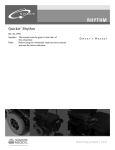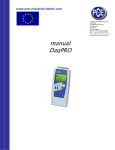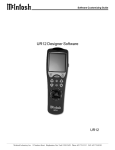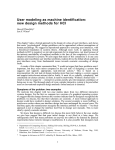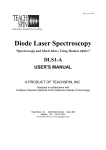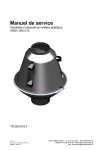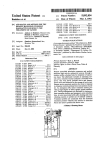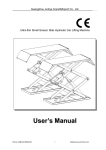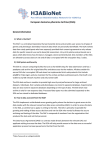Download Intelligent diskette for software protection
Transcript
llllllIllllllllllllllllllllllllllllllllllllllllllllllllllllllllllllllllllll _ USOO5267311A Ulllt?d States Patent [19] [11] Patent Number: Bakhoum [45] Date of Patent: 5 9 267 9 311 Nov. 30, 1993 [54] INTELLIGENT DISKETI‘E FOR SOFTWARE PROTECTION Pagemaker, Aldus; User Manual; Dec. 1987; p. 1-26; Aldus Corp., Seattle, WA. [76] Inventor: P?mary Examiner—stephen C‘ Buczmski [57] ABSTRACT Ezzat G. Bakhoum, PO. Box 2818, Durham, NC. 27715-2818 ' A device for protection of computer software installed [211 App!’ No" 986’667 - _ particularly a device of such type that is embedded [22] Flled' [51] [52] [ss] on hard disks against unauthorized copying and use, and Dec' 8’ 1992 inside an ordinary diskette cartridge. Int. c1.5 ...................... .. H04L 9/00; G1 1B 15/04 US. Cl. ......................................... .. 380/4; 360/60 Field of Search ........................ .. 380/3, 4; 360/60 The deviee depends mainly in its Operation on e VLSI mierocontroller embedded inside the diskette and inter faced to a read/write head placed in contact with the surface of the ?oppy disk. In connection with such [56] References Cited U S PATENT DOCUMENTS device, a method is described to prevent an executable code from being installed on more than one machine, ' ' 4,446,519 even if several machines are present in the same work 5/1984 Thomas . gggzfrg at a!‘ ' 4:858:O36 place. 360/60 8/1989 Ginkel _"""""""""""""""""" " The device of the invention is very convenient for the software user. Together with the convenience, it suc 4,959,861 9 /1990 Howlene _ cessfully achieves two main objectives: ?rst, preventing 4,980,782 12/1990 Ginke] _ 5,122,912 6/1992 Kanota et a1. . the software from getting transferred and used over seas, and secondly, preventing the software from get ting transferred to a friend or colleague in the same OTHER PUBLICATIONS workplace. Pagemaker, Aldus; Ref. Manual; Dec. 1987; p. 2-18; Aldus C0rp., Seattle, WA. 100 36 Claims, 6 Drawing Sheets BatltgeariesBattery Compartment 112 Microcontroller US. Patent Nov. 30, 1993 Sheet 1 of 6 5,267,311 B attery Compartment 1/04 124 / FIG. 1(a) 1 12 10<\ 114 R/W Head ;L//////|/////§' L___J R/O Head 116 Microcontroller US. Patent Nov. 30, 1993 Sheet 2 of 6 5,267,311 89.9 UserMaSk 01100010 202 Allocation Mask % 204 Certification 3 Byte 206 1 1 1 1 () O 1 US. Patent Nov. 30, 1993 Sheet 4 of 6 5,267,311 400 404 T 402 T T Programing Code ( START ) Run by Vendor Write Mask to ’\410 Track 108 Activate R/W Head to Read 8 bytes @408 Erase Track 108 “412 406 T Executable Code 414 Run by User 8 Write Test Password to Track 108 K416 Fetch a Test Password from Track 108 ______________ _ Data Masking/ Allocation (420 Read Confirmation Write Confirmation Password from track 108 Password to Track 108 FIG. 4 418) > US. Patent I Nov. 30, 1993 502 Sheet 5 0f6 5 l V SYNC Bits 5,267,311 J Stop Bits Data FIG. 5 602 Diskette Present‘? 606 Create SVF Proceed U.S. Patent Nov. 30, 1993 Sheet 6 of 6 5,267,311 700 734 Microcontroller 730 SuperS' ft Tampering with this seal will terminate your license agreement. Ser.No. XXXXXX Batteries 722 736 FIG. '7 732 738 1 5,267,311 2 ing by professionals. Further, once the executable code INTELLIGENT DISKE'I'I‘E FOR SOFTWARE PROTECTION is installed on a hard disk (as is usually the case), such protection methods are worthless. It is the objective of the present invention to provide BACKGROUND OF THE INVENTION 5 a device for preventing the use of stolen software. Since 1. Field of the Invention “copy-protection” techniques have failed to prevent This invention relates to a device for protection of software theft, the present invention rather prevents the computer software installed on hard disks against unau execution of the code on the CPU, unless the device of thorized copying and use, and particularly a device of the invention is present in the floppy disk drive of the such type that is embedded inside a diskette cartridge. computer. 2. Important Notice to the Reader of this Patent Ap plication It is another objective of the present invention to This patent application describes a device of a rela provide a method for software protection which is ex tively simple physical structure. However, the mecha tremely convenient for the end user, by featuring an nism by which the device performs its function is new ordinary diskette cartridge that can be easily loaded in and of considerable complexity. the disk drive of the computer each time the software is Every effort has been made to keep the speci?cation run. clear and understandable. However, patience and con It is ?nally the ultimate objective of the present in centration in reading are necessary for understanding. vention to provide a method and device for software The section titled “Software protection in the same workplace” is the most important section of this appli protection which will prevent an executable code from cation and should be read with special care. being installed on more than one machine, even if sev 3. Description of the Related Art eral machines are present in the same workplace. Each year, billions of dollars worth of American Other aspects and features of the invention will be software is stolen overseas. This not only hurts the more fully apparent from the ensuing disclosure and American software developers, but is also extremely appended claims. damaging to the U.S. economy, one of its key elements of strength being technology. SUMMARY OF THE INVENTION In one country half-the-way around the globe, I saw a software merchant advertising: “We sell the latest In a broad aspect, the present invention relates to a version of AutoCad for 15 pounds”. device for preventing unauthorized use of software, Software theft has become a widely spread phenome comprising: non in recent years due to the extreme ease with which a diskette cartridge comprising a housing and a rotat data can be transferred among magnetic media, and the lack of successful means for preventing unauthorized data transfers. a microcontroller embedded inside the housing of It is the object of the present invention to provide such successful device for preventing software theft. The device is an intelligent diskette that accompanies at least one magnetic head interfaced to said mi crocontroller, and placed in contact with the sur able magnetic media placed inside the housing; said diskette; each set of executable diskettes. Without the presence of that device, execution of the code on the CPU is impos sible. face of the magnetic media. Whereby handshaking is accomplished by means of exchanging signals between the embedded microcon In the prior art, several techniques have been devel troller and the host computer, via the magnetic media of oped in attempts to prevent software theft, none of which has been completely successful to date. The ?rst 45 the diskette. attempt was to alter the standard format of storing ?les on the magnetic media to prevent unauthorized duplica tion. But rapidly programs were developed to break this copy-protection scheme. Another attempt was to pro vide an intelligent circuit that connects to the computer via a serial port or internal bus. Unfortunately, how ever, such circuits can easily be duplicated by profes sionals, as they usually depend on a ROM which can be duplicated by various means. Further, the use of an additional piece of hardware for each software program is very inconvenient for the user. A third technique is described in U.S. Pat. No. 4,734,796 issued Mar. 29, 1988 to Grynberg et al, which shows a method for preventing unauthorized copying of diskettes based on inducing surface defects at known locations on the magnetic media. A still further tech nique is shown in U.S. Pat. Nos. 4,858,036 and 4,980,782 issued Aug. 15, 1989 and Dec. 25, 1990, respectively, to Peter Ginkel, which depends on the use of magnetic materials possessing high coercivity to prevent duplica~ tion of diskettes. Unfortunately, however, the techniques of those three patents are still vulnerable to unauthorized copy BRIEF DESCRIPTION OF THE DRAWINGS FIG. 1(a, b) is a schematic representation of an intelli gent diskette according to the present invention, com prising a microcontroller and two magnetic heads. FIG. 2 shows an 8-byte user mask to be programmed and stored inside the microcontroller of the diskette. FIG. 3 is a block diagram illustrating the main princi ple of operation of the microcontroller of the present invention. FIG. 4 is a ?ow chart illustrating the preferred hand shaking method between the intelligent diskette and the host computer, according to the present invention. FIG. 5 shows a synchronization method for data transfer, according to one embodiment of the invention. FIG. 6 is a flow chart illustrating steps to be taken by an executable code, for protection against unauthorized 65 use by different users in the same workplace. FIG. 7 is a schematic representation of an intelligent diskette, according to a different embodiment of the present invention. 3 5,267,311 DETAILED DESCRIPTION OF THE INVENTION, AND PREFERRED EMBODIMENTS THEREOF Basic Structure and Handshaking Techniques The present invention mainly features an intelligent 4 gram, but no data, being stored on the diskettes. Each software vendor will then be able to program his intelli gent diskettes without the risk of letting the manufac turer have access to critical data. 5 Reference is now made to FIG. 1(a) in the drawings. FIG. 1(a) shows an ordinary diskette cartridge 100 device that works in conjunction with an ordinary which may be a 3.5" or 5.25" type diskette. The jacket ?oppy disk. An executable code, supplied by a software or housing of the diskette, 102, preferably made of hard plastic, is shown with a broken section on the right vendor, will check for the presence of such device inside the ?oppy disk drive of the computer, and should hand side, thereby exposing the internal detail to view. The ?oppy disk 104 is shown as rotating counterclock not execute if the device is not present. In conjunction with such intelligent diskette, a method will be further described which will enable the executable code to “recognize” the host computer it wise in the ?gure, with the read/write head of the host computer 106 being positioned over one particular track 108 (the movable head 106 of the host computer is not a part of the diskette and is shown in FIG. 1(a) only was ?rst installed on. This will prevent the code from unlawfully getting installed on several machines in the for clarity). Inside the housing, special provisions are same workplace, with the intelligent diskette being used made to embed a custom-made CMOS microcontroller to activate all such machines simultaneously. 110. The handshaking between the host computer and the The microcontroller 110 is connected to a thin ribbon intelligent diskette will be accomplished by means of 20 connector 112, carrying interface signals to a ?xed polling. As a preferred embodiment of the present in read/write head 114. The head 114 is positioned over vention, the executable code running on the host writes the particularly-chosen track 108, and is in contact with a special stream of bits on the magnetic media of the the surface of the ?oppy disk. The function of head 114 diskette. The microcontroller inside the diskette, in response to such stream, issues a password, which is 25 is to read and write handshaking information. The mi crocontroller is similarly connected with a connector written on the same track of the ?oppy disk, to be later 118 to a fixed read-only head 116 positioned on the read by the host computer and passed to the executable other side of the ?oppy disk, such that the disk is sand code as a certi?cation of the presence of the diskette in witched between the two heads, as shown in FIG. 1(b). the drive. Clearly, such password must be different each time 30 The function of the read-only head 116 is to read syn the intelligent diskette is “polled”; for if the password is chronization pulses from a track 120 on the lower sur constant, it would be a simple matter to professionals to face of the disk. The synchronization track 120 (the function of which will be more emphasized later) serves pick up the password by various means, including direct as a “clocking” means for the microcontroller. The reading from the diskette, and later program the same password on a different intelligent diskette supplied by 35 heads 114 and 116 are preferably embedded within the layers of cushioning material that usually surround the the same manufacturer. Therefore, the intelligent dis kette of the present invention must provide a sequence ?oppy disk. of passwords, such sequence being known only to the It will be therefore apparent that one particular cylin executable code with which the diskette is intended to der in the diskette will be designated to hold two types work. of information, on two different tracks: a data track 108, (My own experience as a professional Engineer has and a synchronization track 120. taught me that a severe mistake is to assume that a given The microcontroller is finally connected to a set of new technology is sophisticated enough so that it is thin Lithium batteries 122, such batteries being installed inside a cavity 124 in the housing. The cavity 124 is accessible from the outside for the purpose of replacing the batteries. (The intelligent diskette should be sup unvulnerable to copying by professional technology pirates. I have seen such individuals in several countries 45 around the world. Any technology which can be dupli cated or stolen by some means will be duplicated and plied to the software vendor with no batteries installed. stolen. My objective in the present invention is to pro The batteries should be installed by the software vendor vide a protection method which by no means can be duplicated). In accordance with the present invention, a technique for the generation of a sequence of passwords will be 50 prior to the programing of the handshaking code). Normally, a microcontroller, which is in most in stances a special-purpose microprocessor, comes equipped with a PC (program counter), an internal bus, a microcode, etc.; in order to allow the fetching and ming” of few bytes of data, to be stored in internal registers inside the microcontroller used in conjunction 55 execution of instructions from a ROM. Such elements, however, are not required in the microcontroller 110 of with the diskette. Such programing is normally done by the present invention. Instead, all control functions of the software vendor, and has the advantage of storing the microcontroller 110 will be implemented by a spe critical data on RAM, rather than ROM; as it is widely cial logic and control circuit, which demands much less known that ROMs can be accessed in virtually any space on a VLSI chip. Such circuit, in fact, will mimic system or device, and the contents of the ROM can be a “control program” directly on silicon, without the obtained by various means. It is true that a ROM can be requirement for formal architecture. The structure of built into the microcontroller at the time of fabrication the proposed microcontroller will be explained in some of the chip, without exposing the data bus for external detail later. access; however, the programing must be done by the Now, with the basic structure of the device being manufacturer in this case. The advantage of using RAM 65 described. Such technique will require the “program is to allow one or more manufacturers to produce intel understood, we shall turn our attention to the main ligent diskettes in mass quantities and supply such dis problem of the present invention, that is, how the intelli kettes to software vendors, with only a control pro gent diskette should generate the sequence of pass 5 5,267,311 6 words, and how the executable code should be able to indicate its presence. Clearly, the decoding method recognize such sequence? must be known to the executable code in order to verify First of all, in order to facilitate the “commercial” handshaking between the manufacturer of intelligent diskettes and the large number of software vendors, it is preferable that the diskette be supplied with a standard control program, as mentioned previously (in our case, such control program will be a “hard-wired” program). This will enable each software vendor to program his own handshaking method, by writing to the diskette an ordinary ?le containing such information, while the control program handles the transfer of data from the magnetic media of the diskette to the internal registers of the microcontroller (this procedure will be explained later in further detail). Without the presence of such control program, the software vendor cannot simply “write” the handshaking information to the diskette as a file. In fact, the microcontroller must be supplied with a standard architecture (i.e., with a program-counter, internal bus, etc.), and the software vendor has the extra burden of doing low-level programing. Such low-level programing may not be done optimally; and most im that the decoding was done correctly. The decoding method must be programmed by the software vendor and stored in the microcontroller’s registers prior to the distribution of software. I shall now explain the preferred embodiment of the present invention. Referring to FIG. 2, a set of registers 200, consisting preferably of 8 registers, are used to store two different types of masks: a “User mask” 202, consisting of 4 bytes, and an “Allocation mask" 204, consisting of 2 bytes. The remaining 2 bytes are used for a special purpose which will be explained later. An incoming test password, consisting of 4 bytes, will go through a bitwise INVERT operation, which is deter mined by the user mask (in the example shown in FIG. 2, the second, third, and seventh bits in the ?rst byte of the test password will be inverted, while the remaining bits in that byte will be left unchanged). A test password 20 may equally be NORed or NANDed with the mask; however such operations are not recommended, since a test password consisting of all 0's or all l’s can some times fool a logic system based on these operations. In any case, the operation must be ?xed and de?ned by the portantly, cannot be done unless the internal bus of the microcontroller is exposed to public use; which may not protect the critical data inside the registers, once the 25 diskette manufacturer. Such preliminary operation has registers are programmed. We therefore see that the the purpose of hiding or “masking” the sequence of bits existence of a standard control program not only saves in the test password. Now, since any logic operation, if space on the VLSI chip, but also prevents lots of trou known, can be reversed, further masking is necessary. ble. The preferred embodiment is to further hide the result With the control program being known, how a hand 30 ing 4 bytes among several bytes of irrelevant data. Since shaking method between the intelligent diskette and the the data in the resulting 4 bytes will be unknown after the masking, it will be impossible to distinguish such host computer should be de?ned to the microcon data from irrelevant data in a long sequence of bytes troller?, and how a sequence of passwords should be generated? Clearly, the control program itself must (this is similar to card game, where several playing handle the generation of such sequence, which must be different for each user. The ?rst idea is to use a different cards are being displayed, with the locations of the signi?cant cards being known only to one player). Such bytes, and which can be used as a “seed” or basis for is the function of the allocation mask 204. Each half byte in the allocation mask indicates how each corre generating a sequence. However, an important problem sponding byte in the masked password should be allo “mask” for each user, which may consist of several arises in such case: how the executable code can keep 4-0 cated within a stream of 16 bytes. In the example of track of the “order” in such sequence? i.e., how to pre vent the executable code from getting “fooled” by pass ing to the code an old password in the sequence? One possible solution, which will prove to be unsuccessful, is FIG. 2, the ?rst byte of data should occupy the 16th position in a stream of 16 bytes, the second byte of data should occupy the 4th position, the third byte of data should occupy the third place in the stream, and the last to maintain a “counter” as a ?le on the hard disk, or else 45 byte should occupy the 10th position. As a result, the executable code running on the host computer issues a test password of 4 bytes and receives a stream of 16 bytes, only 4 bytes of which are meaning ?le each time the code is run to “mark” the most re cently used password. Unfortunately, such scheme will ful. The number of possible allocations in such masking not be successful because a clever user can simply pick 50 scheme is given by l6l/ 12!, or a number in the order of up a password, together with the password ?le (or 43,000. An important question now is: how the irrele vant data should be generated? Clearly, we cannot sim counter ?le) that matches this password, and write that ?le to the hard disk each time before the software is run. ply use a random bit generator on the chip; for if a We can amuse ourselves by thinking of other alterna random bit generator is used, a simple trick would be to tives for solving this problem; but since this may take 55 pass the same test password to the intelligent diskette twice, and simply observe the 4 bytes in the resulting several pages of government paper and several hours of precious reader time, I shall rather state directly that sequence which will remain unchanged. Therefore, a such problem is unsolvable. This will become clear if “pseudo-random” bit generator must be used. Such pseudo-random bit generator must be driven by the test we simply observe that a microcontroller equipped with batteries has means to maintain a “memory”. Such password itself, so that a repeated test password will result in the same l6-byte pattern. However, another memory is not available for an executable code, except pitfall must be avoided here: clearly, the 16-byte pattern on the magnetic media of a disk. must not be completely predictable; for if such pattern The handshaking problem will truly be solved by is completely predictable for a given test password, we using a “two-way” handshaking protocol, rather than to maintain the sequence itself as a long list in a ?le (which may be coded by some means) and update that sequence generation. In a two-way handshaking proto 65 have not solved our problem. How this can be done? col, the executable code sends a “test” password to the The solution can be seen in FIG. 3. FIG. 3 shows a intelligent diskette. The diskette, in turn, “decodes” the pseudo-random bit generator 302 comprising an XOR gate 304 and a feedback shift register 306 (this pseudo test password and issues a “con?rmation” password to 7 5,267,311 random bit generator is a well known circuit, and is described more fully in Principles of CMOS VLSI design, by Weste and Eshraghian, Addison Wesley, 1985, page 266). For generating a pseudo-random sequence of 16 bytes, a 7-bit shift register is required. Now, how to select such 7 bits for initializing the shift register? Since the test password itself must drive the pseudo-random generator, we can simply route a portion of the masked password to shift register 306 in order to start the 16 byte sequence (it is essential to use a portion of the “masked” password, not the original password, to avoid generating a predictable sequence). But before we go any further, we will have to mention a serious draw back of the pseudo-random bit generator 302: it is true that only 7 bits are required to obtain a l6-byte se quence, however such circuit can only generate 128 distinct sequences. This can be seen from the fact that a 7-bit shift register can only have 128 different initial states. The problem now is clear: 128 is a very small number. The 128 different sequences could be even written on a single sheet of paper and compared visually to the output sequence. For that purpose, it is preferable 8 chronization track 120), execution of the control code actually starts when the disk starts rotating. The ?rst step 408 in the control program activates the read/write head 114 in order to read the sequence of 8 bytes. Such sequence of is ?rst written in a serial fashion by the host’s read/write head 106, and then captured by the ?xed head 114 inside the diskette. Clearly, such write~read procedure requires a special synchronization technique in order to enable the head 114 to recognize the data. Such technique will now be explained. First, the programming code 404 running on the com puter reads the DIR (Directory) and FAT (File Alloca tion Table) on the floppy disk. Based on prior informa tion recorded in the DIR and FAT areas, and supplied by the manufacturer, the magnetic head 106 of the com puter is directed to track 108, and seeks the ?rst sector in that track. The programming code then starts to write the sequence of 8 bytes as an ordinary ?le. Such ?le will contain synchronization information beside the 20 mask information. FIG. 5 shows a write-read synchro nization method as a preferred embodiment. As shown in FIG. 5, the host’s magnetic head ?rst writes a long sequence of Sync bits 502, consisting of alternating to make the shift register 306 4-bytes long, and route the High’s and Low’s, as shown. The microcontroller in entire masked password to the shift register (this task will be explained in more detail later). An initial state of 25 side the diskette, now being clocked by the lower syn chronization track 120, detects the Sync bits on upper 4 bytes will result in 232, or some 4000 million distinct track 108, and prepares to capture the S-byte data. The sequences. But, have we solved our problem? de?nitely Sync bits terminate with a sequence of two Stop bits not. It is true that such large number of sequences can 504, and then the data 506 starts. Clearly, the read/write not be written on a sheet of paper, however, a computer simulation can be done to compare “on the fly” all 30 head 114 must be interfaced to a set of 8 shift registers i.e., the masked password. What, then, is the de?nite for storing the mask information. Now, with the 8-byte data being transferred to the microcontroller, the primary objective of the program measure of security in such a system? The de?nite mea ming code has been accomplished (step 410). The pro possible sequences to one particular sequence captured from the diskette, and hence determine the initial state, sure of security is the 4 bytes of the unmodi?ed masked 35 gramming code must now erase track 108 (step 412) by password, which will be “mixed”, or allocated in un known places within the output sequence, thereby mak ing the sequence itself undistinguishable (we recall, again, the idea of the playing cards). If space on the VLSI chip permits, a mask of more than 4 bytes can be used for added security. It should be noted that, for proper protection, the user mask must not be “sparse" in nature; for if a user mask like, for example, 00 . . . 01 is used, we have simpli writing some irrelevant information to that track (clearly, the data should not remain on the disk). The control code then proceeds to the next phase (user phase) and attempts to fetch a test password from the disk (step 414) when the disk starts rotating. As shown in FIG. 4, the executable code 406 writes Sync pulses to track 108, followed by a test password (step 416). By the same write-read mechanism explained previously, the ?xed head 114 inside the diskette fetches the test pass ?ed the job for a technology pirate (this can be seen if a 45 word, and the Data Masking is done on the ?y in step 414 (this procedure will be explained in detail later). test password of all O’s or all l’s is used with such a The microcontroller then writes the l6-byte con?rma mask. In this case, the resulting sequence will be near tion sequence to track 108 (step 418). Later, the execut the very beginning or the very end of the list. A famous able code reads and analyses the con?rmation sequence example in everyday’s life is the combination look. We never set the combination of such locks to be 000 or (step 420). A point of interest is in order here: the mi crocontroller inside the diskette must not be allowed to 999). This is usually not a problem if the software ven write over the header of sector 2 on track 108; i.e., if the dor has to select 4 different bytes for each user, or 232 processing delay is large, the microcontroller may re combinations in total, since any software vendor is not quire more than 4096 clock pulses to accomplish its likely to have such huge number of customers. Referring now to FIGS. 1,3,4 and 5, the functionality 55 mission. That number, (4096: 512 X 8) is the number of bits in sector 1, which is composed of 512 bytes. As of the intelligent diskette will be explained in detail: sector 1 rotates past the magnetic head in the diskette, FIG. 4 shows a ?owchart 400 of the control program the microcontroller receives 4096 clock pulses. How 402 which will be “hard-wired”in the microcontroller’s ever, writing over the header of sector 2 is very unlikely circuitry. In FIG. 4, the control program is interacting, ?rst, with the programming code 404 that should be run 60 to occur because the microcontroller reads some Sync pulses, followed by a 4-byte sequence and then writes by the software vendor in order to transfer the 8 user Sync pulses, followed by a l6-byte sequence; which, in bytes to the micro-controller inside the diskette, and total, is far less than 512 bytes. Nevertheless, such pro then interacting with the testing code 406 (a part of the visions must be taken in the design in order to allow the user-executable code). When the diskette is supplied to the software vendor, the vendor installs the batteries 65 executable code to read the con?rmation sequence as a part of an ordinary ?le. inside the diskette, and the microcontroller starts exe Referring now to FIG. 3, I shall explain the basic idea cuting the control program 402. Since the microcon behind the proposed Masking/Allocation technique. troller is actually clocked by external means (the syn 9 5,267,311 10 Rather than laying down a complex logic circuit, the idea will be explained in “block diagram” form. An incoming test password 308 is fed serially to a circuit 310 for detecting Sync pulses and for performing con of each of the four half-bytes in the Allocation Mask. If the two values match, one of the trapped bytes in the four cyclic shift registers will be routed to the output, trol functions upon such detection. When the two stop bits are detected at the end of the Sync pulse sequence, the circuit 310 starts routing the user mask bits, serially, plexer 332. The control unit 330 features a special out put line 334 which may carry a signal of either 0 or 1. If to an XOR gate 312, where the incoming bits of the test password are properly inverted (the reader can verify that an XOR gate will indeed perform an INVERT operation, determined by a mask, where both the mask bit and the data bit are given as inputs to such gate). At the same instant, an Enable signal is issued to a coun ter/decoder unit 314, having four active-low outputs, by means of a proper selection signal issued to multi one of the trapped bytes in the cyclic registers is being selected, the signal on line 334 is l and the output of multiplexer 332 appears at the output of multiplexer 336. If, however, none of the trapped bytes is selected, the signal 334 is O and the output of the pseudo-random bit generator is selected by the output multiplexer. We will ?nally have to mention a deficiency of the XOR gate 304 used in the pseudo-random bit generator. labeled Inhibit1-Inhibit4. The counter/decoder unit rd 5 It can be observed that, if a particular test password and its complement are used, the two resulting sequences means of which the Inhibit outputs are activated se will be identical, due to the nature of the XOR gate. quentially, one every eight clock pulses. As a result, However, the four hidden bytes of the masked test when the Enable signal is received, Inhibit] becomes password will not be identical in the two sequences. In active for a duration of 8 clock pulses, during which the fact, such four bytes will be complemented in the sec ?rst byte of the masked password 318 is transferred to a ond sequence, which will allow easy identi?cation of cyclic shift register 320, of which a total of 4 registers those bytes. To avoid this trap, a different logic func exist. The cyclic register 320 is equipped with a control tion, such as a NAND, can be used instead of the XOR unit 322, and similarly all other cyclic registers. The gate 304. However, the logic function does not neces control unit 322 has the purpose of detecting an active 25 sarily have to be simple. In fact, such logic function can Inhibit signal and inhibiting the cyclic register from be arbitrarily complicated, and may involve one or operating in a cyclic mode. When Inhibit] becomes more bits of the shift register 306. Further, such logic function must in practice he kept secret by the diskette active, for instance, the register 320 does not operate in manufacturer. a cyclic mode, but instead the ?rst byte of data is trans 314 is clocked by a “divide-by-eight” circuit 316, by ferred to the register. During the following period of 8 30 What are the extra burdens on the software vendor in view of such complexity? Nothing. The software ven clock pulses, Inhibit2 becomes active, while all the dor merely has to prepare 8 different bytes of data for others are inactive. As a result, the control unit 322 opens the feedback path, and register 320 operates in a each user, which will be ?rst incorporated into the executable code and then loaded into the intelligent cyclic mode; while the next cyclic register, 324, accepts the second byte of the masked password; etc. When the 35 diskette (the function of the last two bytes of data has not been yet explained). The intelligent diskette will counter determines that 4 bytes have been received, the then be distributed with the software. The executable control unit 310 removes the Enable signal, and the code does not necessarily have to be modi?ed in order Inhibit outputs are latched high (disabled). (Both logic units 310 and 314 may be operated from a single to incorporate the 8-byte mask, and perform the other functions, such as writing and reading to/from the intel counter. Such detail is not shown in FIG. 3). ligent diskette. All such functions can be built into a As a result of the foregoing, each of the four bytes of standard subroutine and given by the diskette manufac the masked password become trapped in a cyclic regis turer. A single call to such subroutine is then all what it ter, and starts rotating inside the register, once the In takes to get this valuable software protection! hibit signal is disabled (needless to say, all such shift registers must be clocked). Meanwhile, the masked 45 Software protection in the same workplace password is also transferred, as a sequence of 4 bytes, to Now, with the handshaking problem between the the pseudo-random bit generator 302, discussed previ ously. This task is simply implemented by means of a intelligent diskette and the host computer being solved, we shall turn our attention to the most important prob four-input AND gate 326, which gives an active signal if any of the four Inhibit inputs is active. A control unit 50 lem of the present invention: how to prevent unautho rized use of software in the same office or workplace, if 328, upon receiving the active signal, disables the feed back to shift register 306 and routes the masked pass word instead. When the counter reaches the 4-byte count, the con trol unit 310 disables the decoder unit 314, as explained previously, and further issues a signal to a special unit (not shown in FIG. 3), to start writing a burst of Sync an attempt is made to install the software package on more than one machine, and them use the intelligent diskette supplied with the package to activate all such machines? A simple, very efficient technique will now be presented, which will enable the executable code to “recognize” the host computer it was ?rst installed on. pulses, in preparation for issuance of the con?rmation sequence. After the Sync burst is written, the control is not supplied with the code, but is rather created when unit 310 issues an Allocation Enable command to a the code is ?rst run or installed. This ?le, which I shall The idea depends on the use of a software ?le which call the “Sector Veri?cation File”, or SVF, for short, has the only purpose of holding the sector number of the hard disk on which it is actually recorded. For 332, such multiplexer being fed from the four cyclic example, if the SVF is recorded on sector number 3906, shift registers, starting with register 320. The control unit 330 must be linked to the counter. After the Sync 65 then the contents of that tile should actually read “3906". However, that ?le must never be written in burst is written, the counter is reset, and the count then plain ASCII; instead, the information “3906” must be proceeds from OH to FH. At each count, the control control unit 330 that reads the two Allocation Mask bytes and correspondingly activate a 4-bit multiplexer unit 330 compares the value of the counter to the value coded in a manner that is known only to the software 11 5,267,311 12 vendor, i.e., a manner that only the executable code can routed to the output (it is necessary not to route the read, to prevent easy identi?cation of the ?le by inspec tion. Now, why is this coding necessary, despite the fact pseudo-random sequence itself to the output in order to that the location of the SVF can actually be found from the directory of the hard disk? The answer is that the SVF must in reality be mixed with several other support ?les which are created when the executable code is ?rst run or installed, and which are irrelevant to the protec tion of the software. Only the executable code “knows” the name of the SVF ?le. As a result, no one should be able, by simply inspecting the bundle of support ?les created by the code, to recognize which ?le is actually the SVF ?le. It will be nearly impossible for someone who has just installed the software on a new platform, and who is know attempting to copy the support ?les from the original platform, knowing that the SVF ?le is among avoid the possibility of obtaining the certi?cation byte by pure chance). A suitable logic operation for that purpose would be a simple NAND operation. If the intelligent diskette shows that installation has been per formed (i.e., the certi?cation byte does not appear at its expected location), the code should not create the bun dle of support ?les, but instead should attempt to read the SVF ?le from the bundle already existing on the hard disk. FIG. 6 shows a ?owchart 600 that describes the steps taken by the executable code each time the intelligent diskette is called. As shown, step 602 checks for the existence of the diskette in the ?oppy disk drive of the computer. Step 604 then checks for the existence of the certi?cation byte in its expected location. If the certi?cation byte appears in the output, the system pro those ?les, to get all support ?les recorded at exactly the same locations as in the original hard disk (since the ceeds to create the SVF ?le and the other support ?les operating system mainly handles such ?le allocation), unless extremely formidable and time-consuming low 20 appear, the system then veri?es that the contents of the level system management tasks are taken to rearrange (step 608). If not, the system concludes that the software all such ?les at exactly the same locations, together with the pain of moving other information on the hard disk has been illegally copied from its original platform. (step 606). If, however, the certi?cation byte does not SVF ?le match its physical location on the hard disk It will be apparent, then, that the function of the SVF 25 is to work in conjunction with the intelligent diskette in around to make space for the new ?les. the same workplace; with the intelligent diskette pro As an added measure of security, the executable code should really create several SVF ?les (not just one, since one SVF may hit in the right place by chance); all viding hardware means to verify if installation of the to be checked when the code is re-run. installation means that the code has been run at least But how the executable code can recognize, each time the code is run, that installation has been per~ formed in the past, in order to start looking for the SVF ?le, instead of attempting to create a new one? This is the function of the last two bytes of the 8-byte mask once), and with the SVF ?le providing means to verify code has been performed in the past (in this context, that re-installation (or re-running) is being performed on the same computer. But can’t the means for checking prior-installation be done by software, thereby eliminat ing the need for expensive hardware? Unfortunately, stored inside the intelligent diskette. FIG. 2 shows a 35 the answer is no. At the bottom line, any set of diskettes supplied by a software vendor can be copied and in “certi?cation” byte 206 followed by a half-byte 208 stalled on several machines, no matter what the con describing the location of that certi?cation byte in the tents of these diskettes are. Hardware is the only thing l6-byte sequence. In the example of FIG. 2, the certi? that can’t be transferred among magnetic media! cation byte should occupy the ll'h position in the se The SVF idea depends mainly in its operation on the quence. Needless to say, the half-byte 208 must be dif 40 wide physical differences among hard disks, such as ferent from each of the four half-bytes in the Allocation size, speed, coding methods, etc. Fortunately, the lack Mask. The remaining half-byte 210 must always be set to OH when the 8-byte mask is transferred to the dis kette. The function of the half-byte 210 will now be of standardization turned out to be the bene?t of soft ware protection! explained. When the diskette is called for the ?rst time, An important question now arises: if the only purpose of the intelligent diskette is to verify prior-installation, why is all the hassle of the previous section necessary? the contents of the half-byte 210 are checked and veri ?ed to be OH. The certi?cation byte then appears at the particularly chosen location within the sequence, to that is, why transfer masks to the diskette, generate a pseudo-random sequence, etc.; and further, why build a certify that no installation has been attempted in the past. After the ?rst call, the half-byte 210 is set to FH. 50 complex VLSI chip after all? Can't we simply let an “intelligent human” install the software? i.e., let a repre At subsequent calls, the diskette checks the contents of sentative of the software ?rm perform the installation half-byte 210, and the certi?cation byte is not issued if at least one bit is set to 1. It will be apparent, then, that the for each user, so that the user cannot have the software on diskettes. half-byte 210 is in reality a 4-bit “?ag” that is used to That question is a very fair question, and I will now verify prior~installation. It is desirable to have such 4-bit 55 ?ag, as it is common in VLSI systems that one or more answer it in some detail. It is true that such approaches bits in a register may suddenly lose their contents due to a stray ?eld, or other numerous in?uences. can be taken; i.e., the intelligent diskette can truly be eliminated, and the SVF ?le can be solely responsible Now, how such functions can be implemented? In fact, the idea requires minor modi?cations to the basic scheme of FIG. 3. First, the half-byte 208 must be read by the control unit 330, together with the basic Alloca that the function of the intelligent diskette is not merely to verify prior-installation. The true function of such device is to save the software vendor’from getting into tion Mask. When the turn comes for the certi?cation severe trouble. Let us explain: if we assume that no such for software protection. However, I shall emphasize device is present, i.e., no masking or handshaking is byte to appear in the sequence, the multiplexer 332 selects the certi?cation byte if the ?ag 210 is set to OH 65 being performed; what if a user claims that his/her hard disk has crashed, or has been accidentally formatted, or (in fact, multiplexer 332 must be a 5-bit multiplexer). that a catastrophic accident has happened to the com Otherwise, the certi?cation byte undergoes a logic op puter? Normally, the software vendor must re-installed eration with the pseudo-random sequence, and is then 13 5,267,311 14 of the battery compartment with a strong adhesive. The function of sticker 732 will now be explained. As men not only take time and effort, but further, the software vendor may, in reality, be unknowingly helping to in tioned previously, a clever user may attempt to keep his stall the code on a different machine for free. In other intelligent diskette active, and send a “fake” or blank words, without the presence of such intelligent hard diskette to the software vendor, asking for a duplicate ware device, we have not solved much of our problem. copy of the code. The presence of sticker 732 will pre Let us now see how the presence of such nice device vent such action. If the sticker is secured to the diskette will let the software vendor rest in piece: if the user with a strong adhesive, it will be impossible to remove needs re-installation for any reason (including battery the sticker without destroying it. The sticker 732 must failure of the intelligent diskette), the user merely has to O preferably be placed on the top of the battery compart mail his intelligent diskette back to the vendor. In a ?ve ment of the diskette, to further prevent any accidental minute process, the vendor will now transfer a new or “innocent” tampering with the batteries, since any 8-byte user mask to the diskette (thereby rendering the such tampering will result in the stored data being lost. Other alternatives and enhancements to this basic previously-installed code inactive), and then supply the re-programmed intelligent diskette to the user, together 5 idea are possible. For example, one possible alternative the software for the user on a new machine. This will with a new set of software diskettes. The old, or previ ously-installed copy of the code should not be able to recognize the new mask, and will therefore remain would be to place a certain code number for each user inside the battery compartment; such code number to be is a matter of “renewing the license agreement” with the user! checked when the diskette returns back to the vendor (of course, such code number must be different from the serial number of the user). If the user attempts to re move the batteries in order to access his secret code In order to avoid any further pitfalls, the intelligent number, his intelligent diskette will become inactive inactive. In fact, re-programming the intelligent diskette diskette must be marked with the name of the software ?rm and the serial number of the user (clearly, the soft ware vendor cannot recognize one of his own intelli 25 gent diskettes unless it is properly marked). More on this idea will be given shortly. It is important that the SVF ?le be a read-only or hidden ?le, to prevent accidental erasure by the user (all the bundle of support ?les should be marked the same in order to successfully camou?age the SVF ?les). A fur ther technique to enhance the elusive character of an SVF ?le is to make the ?le longer than 2K bytes (by anyway. A still further alternative is to use a metallic sticker 732, with the back of the sticker being placed in contact with the batteries 722, thereby closing the elec tric circuit of the device. Of course, any tampering with the sticker will result in power loss and render the dis kette inactive. While the devices of FIGS. 1 and 7 have been illustra tively described hereinabove with reference to speci?c con?gurations, it will be recognized that the invention may be variously con?gured. One potentially important inserting some irrelevant data. Note that 2K is the clus alternative to the basic structure of the intelligent dis kette will now be discussed in some detail. Referring to ter size on most hard disks), and then storing in the ?le the entire FAT entry for that ?le. By this technique, if the copied SVF ?le hits in the right starting sector FIG. 1, it can be seen that the rotating magnetic disk 104 can be entirely eliminated, and the embedded head 114 can be placed within the rectangular window of the accidentally, it may not necessarily have the same FAT entry as the original ?le. jacket, to come in direct contact with the movable head 106 of the computer, when the head 106 reaches track The foregoing describes only some possibilities af 40 108. In this case, the handshaking signals will not be forded by the SVF idea. In general, I feel that the idea transmitted via the magnetic media of the disk, but is powerful, and several other alternatives and modi?ca rather directly between the two heads. Such an alterna tions are possible within its broad scope. For example, the SVF may be used to describe the physical location tive, while feasible, is not attractive from the Engineer ing stand point, as it will introduce considerable com of an arbitrary data ?le (or a group of ?les), not neces 45 plexities into the system. For instance, such alternative will require that the microcontroller “emulates” a Di sarily its own physical location. In such case, it is not even necessary to “hide” the SVF among other support ?les. The SVF can be clearly named “SVF", and the size of the ?le may be much longer than 2K. Its contents rectory and FAT areas; such areas being present nor mally on a magnetic disk. Further, the microcontroller must emulate a “sector header”, in addition to the other may very well read: “The FAT entry of ?le A is . . . ; The FAT entry of ?le B is . . . ; etc." In this manner, if information, when the computer attempts to “read” from track 108. Finally, the most important dif?culty is the code and its support ?les are installed directly from this: how synchronization between the embedded mi the release diskettes onto a new hard disk, the user crocontroller and the host computer can be achieved? It is true that a crystal can be used for clocking the mi crocontroller, with a frequency that is adjusted accord knows that the SVF ?le cannot be simply “copied” from the original hard disk. It is mandatory that the contents of the SVF must always be coded in a manner that is known only to the software vendor. FIG. 7 shows a modi?ed version of the intelligent ing to the particular speed on track 108; however, per fect synchronization for the write-read operation will require complex circuitry on the VLSI chip. The pres ence of a synchronization track 120 in the original de diskette, 700, with the modi?cation being essentially the addition of an extension 730 to the basic jacket 702. This 60 sign simpli?es things dramatically. In view of such com plexity, the approach of eliminating the magnetic media extension may be added if the size of the VLSI chip 710, from the diskette cartridge is not generally recom together with the set of batteries 722, is large, so that such elements cannot be ?tted into the frame of the mended. Nevertheless, such alternative can be taken without departure from the scope of the invention. main jacket 702. Now, back to the problem of properly Further, while the invention has been shown in a marking the intelligent diskette, we see a sticker 732 65 particular embodiment as an intelligent device embed bearing the name of the software ?rm 734, the serial ded inside a diskette cartridge, it will be appreciated number of the user 736, and a special warning statement that the device may be embedded inside a tape car 738. The sticker 732 must preferably be ?xed on the top 15 5,267,311 tridge, without departure from the scope of the inven tion. Moreover, the preferred software techniques used in conjunction with the intelligent device, such as the described Masking/Allocation method for handshak LII ing, and the Sector Veri?cation File (SVF) for software protection, do not necessarily have to be used in con 16 with the physical sector location of the at least one data ?le; means within said executable ?le for disabling access to the software in case said original and physical sector locations do not match. 13. A method according to claim 12, wherein the veri?cation ?le is the at least one data ?le. 14. A method according to claim 12, wherein the junction with an intelligent “diskette”. In fact, such veri?cation ?le is different from the at least one data techniques can be used with virtually any hardware ?le. device that may be connected to the host computer via 15. A method according to claim 12, wherein the a serial port, a parallel port, or a data bus; without de executable ?le is the at least one data ?le. parture from the scope of the invention. 16. A method according to claim 12, wherein the Finally, while the invention has been described with executable ?le is different from the at least one data ?le. reference to speci?c aspects, features, and embodi 17. A method according to claim 12, wherein the ments, it will be appreciated that various modi?cations, 15 contents of the veri?cation ?le describe the physical alternatives, and other embodiments are possible within locations of multiple data ?les. the broad scope of the invention, and the invention 18. A method according to claim 12, wherein the therefore is intended to encompass all such modi?ca name of the veri?cation ?le is known only to the exe cutable ?le. tions, alternatives, and other embodiments, within its 20 19. A method according to claim 12, wherein the scope. veri?cation ?le is created when the executable ?le is run What is claimed is: for the ?rst time. 1. A handshaking method between two digital sys 20. A method according to claim 12, wherein the size tems, consisting of: of the veri?cation ?le is at least one byte. a test signal, issued by ?rst system; 25 21. A method according to claim 12, wherein the size a con?rmation signal, issued by second system; of the veri?cation ?le is at least 2K bytes. wherein the con?rmation signal comprises a masked 22. A method according to claim 12, wherein the form of the test signal, mixed with other irrelevant. contents of the veri?cation ?le describe the starting data, such that the locations of the masked signal within said irrelevant data are known to the ?rst 30 system. 2. A method according to claim 1, wherein the ?rst system is a computer. 3. A method according to claim 1, wherein the sec ond system is a hardware device for data protection. 4. A method according to claim 1, wherein the sec ond system generates irrelevant data by means of a 35 pseudo-random bit generator. 5. A method according to claim 4, wherein the pseu do-random bit generator is driven by the masked test signal. sector number of the at least one data ?le. 23. A method according to claim 12, wherein the contents of the veri?cation ?le describe the entire FAT entry of the at least one data ?le. 24. A method according to claim 12, wherein the veri?cation ?le is a read-only ?le. 25. A method according to claim 12, wherein the veri?cation ?le is a hidden ?le. 26. A method according to claim 12, wherein the veri?cation ?le is mixed with a bundle of irrelevant ?les. 27. A method according to claim 12, comprising multiple veri?cation ?les. 28. A method according to claim 12, used in conjunc tion with a hardware device for verifying prior-installa tion of the software. 29. A method according to claim 28, wherein the 7. A method according to claim 3, wherein the hard 45 6. A method according to claim 1, wherein the sec ond system comprises cyclic shift registers and control circuitry for allocation of the masked test signal. ware device is embedded inside a diskette cartridge. 8. A method according to claim 3, wherein the hard ware device is embedded inside a tape cartridge. 9. A method according to claim 3, wherein the hard’ ware device is connected to a serial port in the com puter. 10. A method according to claim 3, wherein the hard ware device is connected to a parallel port in the com puter. 11. A method according to claim 3, wherein the hard 55 ware device is connected to the data bus of the com puter. 12. A method for preventing unauthorized use of software by means of detecting the movement of data ?les, consisting of: a veri?cation ?le, wherein the contents of the veri? cation ?le describe the original sector location of at least one data ?le on a hard disk, and wherein such contents are coded in a manner that is unknown to hardware device is embedded inside a diskette car tridge. 30. A method according to claim 28, wherein the hardware device is embedded inside a tape cartridge. 31. A method according to claim 28, wherein the hardware device is connected to a serial port in the computer. 32. A method according to claim 28, wherein the hardware device is connected to a parallel port in the computer. 33. A method according to claim 28, wherein the hardware device is connected to the data bus of the computer. 34. A device according to claim 28, comprising a secret code placed inside a battery compartment for verifying the identity of the device. 35. A device according to claim 28, comprising a label for displaying a name of a software ?rm and for warning against tampering with the device. 36. A device according to claim 35, wherein the label the user in order to prevent tampering with the 65 is metallic for connecting a power source to the device and for disconnecting the power source when the de veri?cation ?le; an executable ?le for reading the contents of said vice is tampered with. r i i it i * veri?cation ?le, and for comparing such contents















